Header Image from National Park Service, New River Gorge National River, Hinton, Beckley, Glen Jean, and Fayetteville, West Virginia
West Virginia became the 35th state on June 20, 1863.
Bird: Cardinal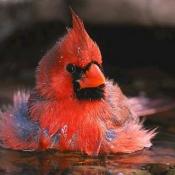 Unlike many other songbirds in North America, both the male and female cardinals can sing. Usually, only a male songbird is capable of singing. When a female cardinal sings from the nest, it usually means she’s telling the male she needs more food. Cardinals mate for life. A group of cardinals has many collective nouns, including a “college”, “conclave”, “deck”, “radiance”, and “Vatican” of cardinals.
Unlike many other songbirds in North America, both the male and female cardinals can sing. Usually, only a male songbird is capable of singing. When a female cardinal sings from the nest, it usually means she’s telling the male she needs more food. Cardinals mate for life. A group of cardinals has many collective nouns, including a “college”, “conclave”, “deck”, “radiance”, and “Vatican” of cardinals.
The cardinal is the mascot of prominent sports teams and schools, including the St. Louis Cardinals (baseball) and Arizona Cardinals (football); it is the state bird of seven states, more than any other bird: Illinois, Indiana, Kentucky, North Carolina, Ohio, Virginia, West Virginia
Flower: Rhododendron Rhododendron leaves and flowers contain toxic substances and should not be taken by humans or animals. The toxin can cause very low blood pressure and heart rate as well as irregular heart rhythm. People have been known to become ill from eating honey made by bees feeding on rhododendron and azalea flowers. Rhododendron is extremely toxic to horses, with some animals dying within a few hours of ingesting the plant. In the language of flowers, the Rhododendron symbolizes danger and to beware.
Rhododendron leaves and flowers contain toxic substances and should not be taken by humans or animals. The toxin can cause very low blood pressure and heart rate as well as irregular heart rhythm. People have been known to become ill from eating honey made by bees feeding on rhododendron and azalea flowers. Rhododendron is extremely toxic to horses, with some animals dying within a few hours of ingesting the plant. In the language of flowers, the Rhododendron symbolizes danger and to beware.
Tree:Sugar Maple Sugar maple is best known for its bright fall foliage and for being the primary source of maple syrup. It takes 40 parts of maple sap to produce only 1 part of pure syrup. The wood from the sugar maple tree is used for making bowling alleys and bowling pins; basketball courts, including the floors used by the NBA; and baseball bats. It is also widely used in the manufacture of musical instruments, such as the members of the violin family (sides and back), guitars (neck), and drum shells.
Sugar maple is best known for its bright fall foliage and for being the primary source of maple syrup. It takes 40 parts of maple sap to produce only 1 part of pure syrup. The wood from the sugar maple tree is used for making bowling alleys and bowling pins; basketball courts, including the floors used by the NBA; and baseball bats. It is also widely used in the manufacture of musical instruments, such as the members of the violin family (sides and back), guitars (neck), and drum shells.
State Quarter
From theus50.com
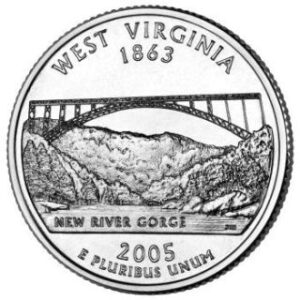
This coin captures the scenic beauty of the State with its depiction of the New River and the New River Gorge Bridge. The coin bears the inscription “New River Gorge”.
Prior to gaining statehood, the area that is now West Virginia formed the western part of Virginia. Settlers in the western part of the “Old Dominion” began their efforts to join the federal Union when Virginia announced its secession in 1861. In the western part of the State, the Restored Government of Virginia in Wheeling drafted a state constitution in 1862. The new state called West Virginia applied to Congress for admission into the Union. Congress approved the request with one condition, that the new state abolish slavery. President Lincoln signed the West Virginia statehood bill and on June 20, 1863, West Virginia officially became the 35th state to be admitted into the Union.
Capital: Charleston
Nickname: Mountain State
Motto: Mountaineers are always free
West Virginians often refer to their state as “Almost Heaven,” in reference to John Denver’s “Take Me Home, Country Roads,” which name-checks the Mountain State. The phrase even used to appear on state license plates. So beloved is Denver’s ode to rural life that in 2014 it became the official song of West Virginia.
West Virginia Facts and Trivia
West Virginia was originally part of the Virginia Colony which had been established by England in 1606.
Settlers began to arrive in western Virginia in the 1700s. Many of these early settlers were of German descent and came from Pennsylvania in the north looking for new lands. In 1726, they established the settlement of New Mecklenburg. Later, in 1762, it would become the city of Shepherdstown, the oldest town in West Virginia. These early settlers had to deal with hostile Native Americans who considered West Virginia their hunting grounds.
Sectional differences brewed inside Virginia for decades before the Civil War. West Virginia was still part of the Virginia Colony during the Revolutionary War. West Virginia had always been separated physically from Virginia by the Appalachian Mountains. As a result, it was a very different area in terms of culture and economics.
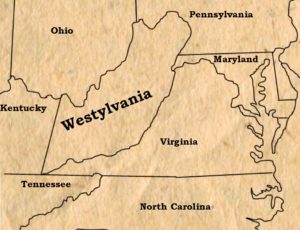 In 1775, a group of 2,000 residents signed a petition asking the Continental Congress to create a 14th colony called Westsylvania, which would have encompassed all of today’s West Virginia along with portions of Maryland, Virginia, Kentucky and Pennsylvania. The Continental Congress ignored the petition along with another plea in 1783 to make Westsylvania the 14th state.
In 1775, a group of 2,000 residents signed a petition asking the Continental Congress to create a 14th colony called Westsylvania, which would have encompassed all of today’s West Virginia along with portions of Maryland, Virginia, Kentucky and Pennsylvania. The Continental Congress ignored the petition along with another plea in 1783 to make Westsylvania the 14th state.
Moonshine
The making of illegal or moonshine whiskey has a long history in West Virginia and elsewhere. In West Virginia, field corn, soft creek water, and industrious farmers came together to make moonshine, sometimes also called mountain dew or white lightning. Moonshine is typically 100-proof whiskey, aged little or none, and was an important cash crop. So long as revenue agents did not cause trouble, making moonshine was an efficient and profitable way to market corn. With a good still, one-and-a-half bushels of corn was reduced to a gallon of whiskey, which was worth more than the grain itself and less bulky to transport.
From the mid-18th century, settlers from Scotland, Ireland, Wales, and England came to the mountains with distilling equipment and the necessary know how. They quickly adapted their Old World recipes to include American field corn. Whiskey was drunk in far greater quantities than today and used to barter for salt, nails, and taxes. Some used it to buy property, and a good copper still and the condensing coil or ‘‘worm’’ had considerable value themselves.
On March 3, 1791, soon after the colonies became a nation, Congress imposed the first taxes on stills and whiskey. Such laws caused the 1794 Whiskey Rebellion, an uprising in western Pennsylvania and parts of present West Virginia. The settlers, mainly Scotch-Irish, saw the tax as unfair. President Washington himself led troops to stop the rioting, and the federal government kept the tax in force for 11 years. Whiskey remained untaxed from then until 1862, except for three years following the War of 1812.
Sohn, Mark F. “Moonshine.” e-WV: The West Virginia Encyclopedia. 20 October 2010.
1859 – Abolitionist John Brown led a raid on the Harpers Ferry arsenal in an attempt to arm the slaves. Originally part of Virginia, Harpers Ferry is located in the eastern panhandle of West Virginia near the convergence of the Shenandoah and Potomac rivers.
In the wake of Virginia’s secession from the Union in 1861 , a convention of delegates from western Virginia met in Wheeling for the purpose of forming the “State of Kanawha,” which incorporated 39 counties. The name honored a Native American tribe and a major state river of the same name. When the constitution for the proposed state was finalized in 1862, however, the name had changed to the more generic West Virginia. On June 20, 1863, West Virginia became the 35th state. West Virginia is the only state in the Union to have acquired its sovereignty by proclamation of the President of the United States (Abraham Lincoln).
Although West Virginia split from Virginia and remained in the Union, there were West Virginians who fought on both sides of the war. The Union maintained control of much of the state throughout the war, but there were still many battles inside the state including the Battle of Shepherdstown, the Battle of Harpers Ferry, and the Battle of Droop Mountain.
Following the Civil War, battle-torn Virginia claimed that its new neighbor was responsible for a third of its pre-war debt. West Virginia refused to pay, and the two states squabbled all the way up until 1915, when the U.S. Supreme Court determined that West Virginia, in line with its state constitution, owed $12 million, plus additional interest. Begrudgingly, West Virginia complied, paying off the last of its debt to Virginia in 1939.
West Virginia is considered the southern most northern state and the northern most southern state.
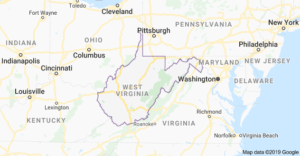 Some people think this state’s shape looks like a leaping frog, with its nose in the southwestern corner. It’s bordered by Ohio, Pennsylvania, and Maryland in the north; Maryland and Virginia in the east; Virginia and Kentucky in the south; and Kentucky and Ohio in the west. Its wiggly western border is created by the Ohio River, while its winding eastern border is created by the Appalachian Mountains. It can be divided into two geographical regions.
Some people think this state’s shape looks like a leaping frog, with its nose in the southwestern corner. It’s bordered by Ohio, Pennsylvania, and Maryland in the north; Maryland and Virginia in the east; Virginia and Kentucky in the south; and Kentucky and Ohio in the west. Its wiggly western border is created by the Ohio River, while its winding eastern border is created by the Appalachian Mountains. It can be divided into two geographical regions.
The Appalachian Ridge and Valley Region includes the Appalachian and Blue Ridge Mountains, which start in the northeast and run southwest. This region is known for its parallel ridges that were cut by streams, as well as canyons called “water gaps.” Forests, caves, and high peaks dot this area, including the state’s highest point, Spruce Knob.
The Allegheny Plateau spreads across the rest of the state, and has flat-topped hills and rounded peaks. Deep, stream-cut gorges and a wall of mountains called the Allegheny Front separates the state’s two regions.
Anyone looking at a map of West Virginia might wonder about the sliver of land rising north like a radio antenna. How’d that get there, anyway? Chalk it up to Virginia’s overly eager settlers, who in the late 1700s claimed land north along the Ohio River, ignoring Pennsylvania’s borders. In 1779, the two states agreed to a border five degrees west of where the Mason Dixon line ended, and north to the Ohio River. After Virginia ceded its territory west of the river to the U.S. government in 1784, that left just a thin northern panhandle.
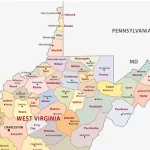 West Virginia is the only state with two panhandles; the Eastern and the Northern panhandles. The Eastern Panhandle stretches from the northeastern part of the state and borders the states of Virginia and Maryland. The panhandle includes the lowest and highest elevations in West Virginia and is separated from the rest of the state by the Allegheny Front. It covers about 8 counties including Berkeley, Grant, Hampshire, Hardy Jefferson, Mineral, and Morgan. The Northern Panhandle is the northernmost extension of West Virginia, bordering the state of Pennsylvania and Ohio. The area covers four counties, namely Marshall, Ohio, Brook, and Hancock.
West Virginia is the only state with two panhandles; the Eastern and the Northern panhandles. The Eastern Panhandle stretches from the northeastern part of the state and borders the states of Virginia and Maryland. The panhandle includes the lowest and highest elevations in West Virginia and is separated from the rest of the state by the Allegheny Front. It covers about 8 counties including Berkeley, Grant, Hampshire, Hardy Jefferson, Mineral, and Morgan. The Northern Panhandle is the northernmost extension of West Virginia, bordering the state of Pennsylvania and Ohio. The area covers four counties, namely Marshall, Ohio, Brook, and Hancock.
West Virginia’s politicians had a hard time settling on a capital city early on. Wheeling, the original capital, was deemed too remote, so in 1870 the government moved to centrally located Charleston. But Charleston, many legislators complained, didn’t have suitable restaurants, hotels, or transportation. So in 1875 everything shifted back to Wheeling. The debate continued, and in 1877 the government decided to put the matter before voters—who chose Charleston. In 1885, West Virginia’s government moved to Charleston for a second and final time.
West Virginia has an average altitude of 1,500 feet, the highest average altitude east of the Mississippi.
West Virginia has the oldest population of any state. The median age is 40.
15 percent of the nation’s total coal production comes from West Virginia.
About 75 percent of West Virginia is covered by forests.
A variety of the yellow apple, the Golden Delicious, originated in Clay County. The original Grimes Golden Apple Tree was discovered in 1775 near Wellsburg.
The first steamboat was launched by James Rumsey in the Potomac River at New Mecklensburg (Shepherdstown) on December 3, 1787.
In 1796, soldiers in Greenbrier County came across animal bones believed to belong to a very large lion. They sent the fossils to Thomas Jefferson, an amateur paleontologist and soon-to-be vice president, who concluded the remains were that of a giant sloth, which he called “Great claw, or Megalonyx.” He presented a paper to the American Philosophical Society and, believing the animal could still be in existence, told Lewis and Clark to keep an eye out along their journey westward. Scientists would eventually credit Jefferson with discovering the giant sloth, and even named the species after him: Megalonyx jeffersonii. In 2008, the skeleton became the official fossil of West Virginia.
George Washington’s brothers built estates that still stand in West Virginia.
George Washington wasn’t the only member of the family to have a town named in his honor. His youngest brother Charles moved to western Virginia and in 1780 built an estate called Happy Retreat, out of which he set aside 80 acres for the creation of Charles Town, which was founded in 1786 and named in his honor. Another Washington brother, Samuel, constructed another nearby estate, Harewood, which was the location of James and Dolley Madison’s 1794 wedding. (George Washington himself surveyed the lands of western Virginia as a youth and purchased land along the Bullskin Run in present-day Berkeley County.)
On February 14, 1824, at Harpers Ferry, John S. Gallaher published the “Ladies Garland,” one of the first papers in the nation devoted mainly to the interests of women.
The Hatfields of West Virginia and McCoys of Kentucky begin to feud in 1880.
Stone that was quarried near Hinton was contributed by West Virginia for the Washington Monument and arrived in Washington in February 1885.
The first rural free mail delivery was started in Charles Town on October 6, 1896, and then spread throughout the United States. Rural Free Delivery (RFD) was inaugurated in West Virginia. While city dwellers began to receive free mail delivery in 1863, the same was not true for the majority of Americans who lived in rural areas. Farm families needed to travel to distant post offices to retrieve their mail or hire private companies to deliver. When RFD service began in 1896, Postmaster General William Wilson introduced it first to his home state.
Outdoor advertising had its origin in Wheeling about 1908 when the Block Brothers Tobacco Company painted bridges and barns with the wording: “Treat Yourself to the Best, Chew Mail Pouch.”
Mother’s Day was first observed at Andrews Church in Grafton on May 10, 1908. Two years after Grafton, West Virginia, native Ann Jarvis passed away in 1905, her daughter Anna invited several friends to her home to commemorate her mother’s life. There she announced her idea to establish a national day of honor for all mothers. On May 10, 1908, Grafton’s Andrews Methodist Church, where Ann Jarvis taught Sunday School for two decades, hosted the first official Mother’s Day service. West Virginia issued the first Mother’s Day proclamation in 1910, four years before a joint resolution in the U.S. Congress designated the second Sunday in May as Mother’s Day. The church is now home to the International Mother’s Day Shrine.
West Virginia was the first state to have a sales tax. It became effective July 1, 1921.
In 1928, the Jones family of Peterstown discovered a 34-carat diamond on their property while playing horseshoes. Initially thinking it a large quartz rock, William “Punch” Jones kept the diamond in a cigar box for fourteen years before taking it to a geologist at Virginia Polytechnic Institute. The Jones Diamond, which was on display at the Smithsonian Institute before the family sold it in 1984, is the largest alluvial diamond ever discovered in North America.
In 1949, residents of Mole Hill, West Virginia, changed the name of their town to “Mountain”.
The New River Gorge Bridge near Fayetteville is the second highest steel arch bridge in the United States. The bridge is also the longest steel arch bridge (1,700 feet) in the world. Every October on Bridge Day, the road is closed and individuals parachute and bungee cord jump 876 feet off the bridge. Its West Virginia’s largest single day event and attracts about 100,000 people each year. The Bridge was started in 1974, completed in 1977.
Today West Virginia is one of the nation’s most rural states, with 77 people per square mile. Neighboring Virginia has more than 200 per square mile. There are very few drives in West Virginia that follow straight lines. Roads wind around mountains and valleys, connecting small dots on a map to one another. Its population is more than 92 percent white. Since 2010, West Virginia is the only state in the union that has lost population, according to the U.S. Census Bureau. Coal production in Boone County has dropped from 22,400 tons in 2010 to 8,400 in 2015.
There’s a town in West Virginia named Iaeger. It’s considered the most difficult to pronounce name in the state. It’s got two syllables: Yay-gur.
From the time of the Great Depression through the 1990s, the politics of West Virginia were largely dominated by the Democratic party.
In the 1992 presidential election, Democrat Bill Clinton won West Virginia by a solid 13 percentage points. In the 2000 presidential election, George W. Bush claimed a surprise victory over Al Gore, with 52% of the vote; he won West Virginia again in 2004, with 56% of the vote.
In November 2016, Republican Donald Trump captured the state in a walk — winning it by more than 40 percentage points.
Strange Laws
No children may attend school with their breath smelling of “wild onions.”
Doctors and dentists may not place a woman under anesthesia unless a third person is present.
It is illegal to snooze on a train.
Whistling underwater is prohibited.
A person may not hold public office if he or she has ever participated in a duel.
In West Virginia it is illegal to use a drone “or other unmanned aircraft” to hunt birds. While you’re out in the woods, you’d better not use a ferret instead of a hunting dog; that’s a $100 fine right there.
In West Virginia, it’s legal to take roadkill home for dinner.
People
- Pearl S. Buck, author
- Joanne Dru, actress
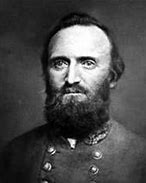 Thomas Stonewall Jackson, Confederate general
Thomas Stonewall Jackson, Confederate general- Don Knotts, actor
 Peter Marshall, TV host
Peter Marshall, TV host- Kathy Mattea, country music singer
- Mary Lou Retton, Olympic medal winner for gymnastics
- Walter Reuther, labor leader
- Cecil Underwood, West Virginia’s oldest and youngest governor. In 1956 the 34 year old former teacher was elected. Due to term limits in the state constitution, he was unable to run for re-election. He ran and was elected 40 years later (1996) at the age of 74.
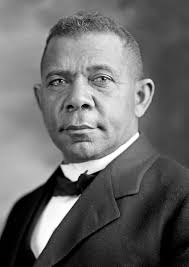 Booker T Washington, political leader, educator, and author
Booker T Washington, political leader, educator, and author- Chuck Yeager, test pilot and Air Force general
Credits:
See ducksters.com
See History.com
See MentalFloss.com
See 50 states.com
See NationalGeographic
See NBC News
See WV encyclopedia/moonshine
See rd.com
See world atlas.com
